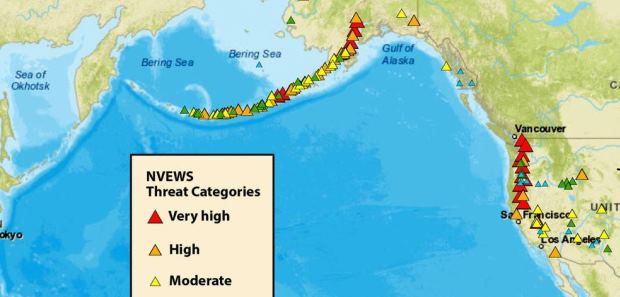
Eighteen Volcanoes Ranked Highest in New USGS Threat Assessment
The new assessment updates one done in 2005. It indicates 161 U.S. volcanoes pose potential threats to American lives and property. The eighteen very highest threat volcanoes are in Alaska, California, Hawaii, Oregon, and Washington, while 39 other volcanoes are high threat, 49 are moderate, 34 are low, and 21 are very low threat.
The U.S. Geological Survey recently updated its 2005 Volcanic Threat Assessment. The new assessment indicates 161 U.S. volcanoes pose potential threats to American lives and property, which is eight fewer than in 2005. The eighteen very highest threat volcanoes are in Alaska, California, Hawaii, Oregon, and Washington, while 39 other volcanoes are high threat, 49 are moderate, 34 are low, and 21 are very low threat.
USGS published its first national volcanic threat assessment in 2005 in support of establishing a National Volcano Early Warning System. The assessment helps to prioritize U.S. volcanoes for research, monitoring, and mitigation efforts based on objective measures of volcano hazards and exposure of people and infrastructure to those hazards.
"More than ten percent of the world’s known active and potentially active volcanoes are within U.S. territories," said John Ewert, a USGS geologist and lead author of the updated Volcanic Threat Assessment. "All of these volcanoes pose some degree of risk to people and infrastructure."
Ewert and his USGS colleagues applied specific criteria to each volcano to derive a score and grouped volcanoes into five threat categories, from very high to very low. "The ranking is not a list of which volcano will erupt next. Instead, it is a way to help focus attention and resources where they can be most effective," he said.
The three U.S. volcanoes ranked as the greatest threats should be familiar names to most Americans -- Kilauea in Hawaii, followed by Mount St. Helens and Mount Rainier in Washington state. Ranked fourth is Redoubt Volcano in Alaska, which erupted in 2009, causing more than 300 flights to be canceled and Ted Stevens Anchorage International Airport to shut down. The eruption of Mount St. Helens in 1980 leveled large tracks of forest, killed people tens of miles away from the mountain, and its debris avalanches and mudflows choked rivers and destroyed bridges, according to USGS.
Since 1980, there have been 120 eruptions and 52 episodes of notable volcanic "unrest" at 44 U.S. volcanoes, the agency reports.
The updated Volcanic Threat Assessment combines 24 criteria (15 hazard factors and nine exposure factors) that describe an individual volcano's hazard potential and the exposure of people and property to those hazards. The hazard factors include volcano type, eruptive history, explosiveness, time between eruptions, types of hazards from past eruptions, and effects of the hazards. Also included is an analysis of what the volcano is doing at present, with a focus on seismicity, ground deformation, and degassing.
Volcanoes added to the 2018 assessment include Salton Buttes in California (high threat); Soda Lakes in Nevada (moderate threat); and Tana in Alaska (low threat). Six additional volcanoes from the Commonwealth of the Northern Mariana Islands, along with three volcanoes from American Samoa, were added, and some volcanoes were removed after more sophisticated age-dating techniques found a lack of eruptive activity in the past 11,000 years.